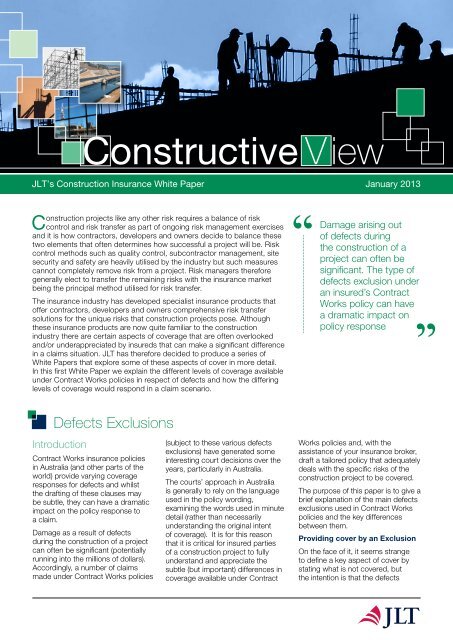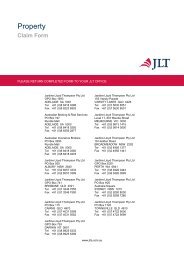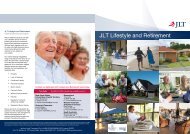Construction White Paper - JLT
Construction White Paper - JLT
Construction White Paper - JLT
You also want an ePaper? Increase the reach of your titles
YUMPU automatically turns print PDFs into web optimized ePapers that Google loves.
Table of ComparisonThe following table demonstrates which costs are typically excluded when damage is caused by defects of design, plan,specification, materials or workmanship under the various DE and LEG exclusions (denoted by red) and conversely whichcosts are typically covered (denoted in green). The hatched (orange) area denotes those costs that may be included orexcluded depending on the circumstances.DE1 DE2 DE3 DE4 DE5 LEG1 LEG2 LEG3Costs to remedy defects whereno damage has occurredCosts to remedy resultantdamage due to defectsCosts to remedy resultantdamage to Property supportedby defective propertyCosts to remedydefective propertyCosts to remedy defectivepart, portion or itemLoss, damage or costsincurred to access defectiveCosts to improve originaldesign, plan, specification,workmanship or materialComments1. Apart from DE1 and LEG1/96 the clauses include a final paragraph that clarifies that the mere existence of a defect(without damage) does not constitute damage itself.2. The LEG2/96 and LEG3/06 clauses approach the issue of what is excluded by way of an exclusion solely related to thecost of replacement or rectification, rather than through an exclusion of damage and costs (DE3 & DE4). Note also thatLEG2/96 and LEG3/06 use the term portion rather than “item’ or “part” or “component part”.3. There is a fundamental difference with regard to the wordings, between DE2 to DE5 and the other defects wordings inthat DE2 to DE 5 relate to property that is in a defective condition whilst the other clauses relate to damage caused bythe defect. The trigger for cover under DE2 to DE5 is that damage must be caused to other property which is free fromsuch defect but is damaged in consequence of the defect.
Practical Application of the DE and LEG ClausesIn practice bespoke Contract Worksinsurance policy forms includeeither DE3, DE4 or DE5 or LEG2or LEG3. The use of DE1/LEG1 isrestricted to some insurers’ “offthe shelf” policy wordings andwould not be acceptable to mostinsureds, or indeed compliant with,for example, the Australian StandardAS4000 1997 Form of Contractwhich requires at least DE2 cover.However, in practice, it is rare to seecover below DE3 or LEG2.In the Australian market a relativelyhigh level of deductible is appliedto cover under DE5 or LEG3. It isnot unusual for a policy’s standarddeductible to apply to cover underDE3 (or DE4) or LEG2 where that,more restricted, scope of coveris selected.Coverage with a “DE3 (or DE4)/DE5Option” or “LEG2/LEG3 Option” canbe secured in the market. Whereprovided, in the event of a claim, theoption lies with the insured to decidewhich level of cover will give the bestresult having regard to the deductiblesthat apply. For example, where thevalue of the defective part itself is lessthan the higher deductible applied tothe DE5 or LEG3 Clause, it may bepreferable to seek cover excluding thedefective part, under the DE3 (or DE4)or LEG2 Clause option to which alower deductible applies.Whilst the LEG Exclusion Clauses aremore usually thought to be relevantto Engineering Risks on MachineryErection/Process Engineeringtype projects rather than standard<strong>Construction</strong> Risks for Building or CivilEngineering projects, it has become amatter of preference of the insured orinsurers as to which are used.ExampleIn this example we look at adefective roof structure and howdifferent defects exclusionswould respond.A number of steel framedIndustrial units are being erectedon an estate. The designers havemiscalculated the stress on thebolts that secure the roof beamstogether. Mid-way through theproject bolts fail as the finalroofing panels are being fittedto one unit, which collapsesdamaging the neighbouringcompleted unit.Costs are incurred for replacingthe bolts that failed, replacing theroof structure that was damagedwhen it collapsed, makinggood damage to the supportingwall, repair of damage to theneighbouring unit, redesigncosts for the defective bolts andreplacement of the bolts alreadyfitted in the other units.ExclusionDE1DE2DE3DE4DE5LEG 1/96LEG 2/96LEG 3/06ALL ExclusionsExcluded costsThis is an outright defects exclusion - All costsare excludedThis clause excludes property which is in a defectivecondition and property which relies on the defectiveproperty for support. Namely the roof and roof panelsThe property which is in a defective condition i.e.the roof frame and bolts which constitute an integralstructure is excluded but all property which is freeof defects including the roofing panels and the wallwould be coveredIn this case it is only the cost of the bolts thatare excluded.It is only the additional cost of improving the designthat is excludedThis is an outright defects exclusion - All costsare excludedThe cost excluded is the cost that would have beenincurred to replace the bolts had it been establishedthat they were defective prior to the failure.It is only the additional cost of improving the designthat is excludedThe cost of replacing the defective bolts in theother units which have not suffered damage.
For more information, please contact:Peter JeevesDivisional ManagerTel: +61 7 3246 7506Email: Peter.Jeeves@jlta.com.auMarcus PearsonManaging Director - Business DevelopmentTel: +61 2 9290 8136Email: Marcus.Pearson@jlta.com.auJardine Lloyd Thompson Pty Ltd ABN 69 009 098 864 AFS Licence No.226827Level 11, 66 Clarence Street, Sydney NSW 2000. Phone: +61 2 9290 8000Fax: +61 2 9299 7280 www.jlta.com.au







